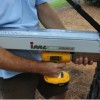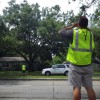 Urban trees provide shade and beauty and the urban forest as a whole provides a wealth of benefits to neighborhoods and residents. But stresses from the urban environment may lead to problems that pose an unacceptable safety risk to people and property. It is a landowner’s responsibility to ensure that the trees on their property are safe. A key step in reducing the potential for tree-related injury or property damage is learning to identify common tree defects associated with increased risk of failure. This 5-page fact sheet highlights seven easily reconizable tree defects that homeowners and non-professionals in public agencies. may encounter in Florida. Written by Drew C. McLean, Andrew K. Koeser, Robert J. Northrop, and Gitta Hasing, and published by the UF Department of Environmental Horticulture, October 2014. (Photo by Gitta Hasing)
Urban trees provide shade and beauty and the urban forest as a whole provides a wealth of benefits to neighborhoods and residents. But stresses from the urban environment may lead to problems that pose an unacceptable safety risk to people and property. It is a landowner’s responsibility to ensure that the trees on their property are safe. A key step in reducing the potential for tree-related injury or property damage is learning to identify common tree defects associated with increased risk of failure. This 5-page fact sheet highlights seven easily reconizable tree defects that homeowners and non-professionals in public agencies. may encounter in Florida. Written by Drew C. McLean, Andrew K. Koeser, Robert J. Northrop, and Gitta Hasing, and published by the UF Department of Environmental Horticulture, October 2014. (Photo by Gitta Hasing)
http://edis.ifas.ufl.edu/ep507
Tag: Tree Care
Advanced Tree Risk Assessment: Resistance Recording Drills
 Resistance recording drills are specialized pieces of decay detection equipment that may be used as part of an advanced risk assessment. While not required for tree risk assessment work, resistance recording drills have been shown to be effective in helping arborists detect and document internal tree decay in trees. This 5-page fact sheet was written by Drew McLean, Andrew Koeser, and Gitta Hasing, and published by the UF Department of Environmental Horticulture, October 2014.
Resistance recording drills are specialized pieces of decay detection equipment that may be used as part of an advanced risk assessment. While not required for tree risk assessment work, resistance recording drills have been shown to be effective in helping arborists detect and document internal tree decay in trees. This 5-page fact sheet was written by Drew McLean, Andrew Koeser, and Gitta Hasing, and published by the UF Department of Environmental Horticulture, October 2014.
http://edis.ifas.ufl.edu/ep504
Tree Risk Assessment Methods: A Comparison of Three Common Evaluation Forms
 All trees pose some level of risk to nearby people, structures, and utilities. As trees age or become weakened by pests, disease, and/or other stresses, a tree owner or manager may need to decide what risk level he or she is willing to accept and what modifications may be needed. Experienced arborists can aid in this decision process by conducting a professional risk assessment that specifies the likelihood of whole or partial tree failure, the consequences of such a failure, and the potential targets affected. A variety of risk assessment methods have been developed to guide professionals through the tree inspection process. In North America, three risk assessment methods have gained the greatest acceptance among tree care professionals, municipal urban forestry programs, and government agencies. This 8-page fact sheet was written by Andrew K. Koeser, Gitta Hasing, Drew McLean, and Rob Northrop, and published by the UF Department of Environmental Horticulture, November 2013.
All trees pose some level of risk to nearby people, structures, and utilities. As trees age or become weakened by pests, disease, and/or other stresses, a tree owner or manager may need to decide what risk level he or she is willing to accept and what modifications may be needed. Experienced arborists can aid in this decision process by conducting a professional risk assessment that specifies the likelihood of whole or partial tree failure, the consequences of such a failure, and the potential targets affected. A variety of risk assessment methods have been developed to guide professionals through the tree inspection process. In North America, three risk assessment methods have gained the greatest acceptance among tree care professionals, municipal urban forestry programs, and government agencies. This 8-page fact sheet was written by Andrew K. Koeser, Gitta Hasing, Drew McLean, and Rob Northrop, and published by the UF Department of Environmental Horticulture, November 2013.
http://edis.ifas.ufl.edu/ep487